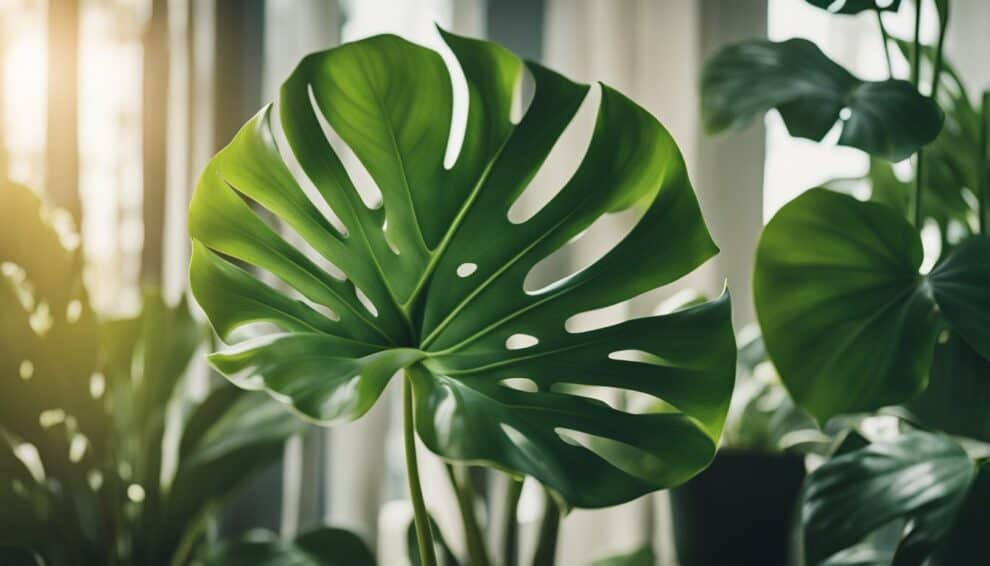Monstera Deliciosa, also known as the Swiss Cheese Plant, is a popular houseplant that has become a staple in many homes.
Its distinctive leaves, which have holes and cuts in them, give it a unique and eye-catching appearance.
While it may seem like a difficult plant to care for, Monstera Deliciosa is actually quite easy to maintain, making it an excellent choice for beginners.

One of the most interesting things about Monstera Deliciosa is its origins.
Native to the rainforests of Central and South America, this plant has been used for centuries by indigenous people for its medicinal properties.
In addition to its medicinal uses, Monstera Deliciosa is also prized for its fruit, which is said to have a taste similar to a combination of pineapple and banana.
However, the fruit is not commonly found in stores and is difficult to grow in most home environments.
Despite its exotic origins, Monstera Deliciosa is a hardy plant that can thrive in a variety of conditions.
It prefers bright, indirect light and well-draining soil, but can tolerate lower light levels and occasional neglect.
With a little bit of care, this plant can grow to be quite large and impressive, making it a great addition to any home.
Getting to Know Monstera Deliciosa
Origins and Habitat
Monstera Deliciosa is a tropical plant that is native to the rainforests of Central and South America.
It is a member of the Araceae family, which includes other popular houseplants like the Philodendron and the Peace Lily.
In the wild, Monstera Deliciosa can grow up to 70 feet tall, with leaves that can reach up to three feet in length.
The plant is known for its distinctive leaves, which are large, glossy, and have unique holes and splits, hence the nickname “Swiss Cheese Plant”.
Common Names and Characteristics
Monstera Deliciosa is commonly known by a variety of names, including the Split-Leaf Philodendron, Hurricane Plant, and Mexican Breadfruit.
The plant is popular among houseplant enthusiasts due to its unique appearance and ease of care.
When grown indoors, Monstera Deliciosa typically reaches a height of six to eight feet, making it a great choice for those with limited space.
The plant prefers bright, indirect light and well-draining soil.
It is also important to keep the plant away from drafts and to water it regularly, allowing the soil to dry out slightly between waterings.
Overall, Monstera Deliciosa is a fascinating and beautiful plant that can add a touch of tropical flair to any home.
With a little care and attention, it can thrive indoors and provide years of enjoyment for its owners.
Caring for Your Swiss Cheese Plant

Light and Temperature Requirements
The Monstera Deliciosa plant prefers bright, indirect light. Direct sunlight can cause damage to the leaves.
It can tolerate low light conditions, but growth may be slow. Keep the plant in a warm room with a temperature range of 65-85°F (18-29°C).
Avoid placing it near cold drafts or air conditioning vents.
Watering and Humidity Tips
The Swiss Cheese Plant prefers slightly moist soil. Water the plant thoroughly once a week, and allow the soil to dry out slightly before watering again.
Overwatering can lead to root rot. The plant thrives in a humid environment, so mist the leaves regularly or place a humidifier nearby.
Soil and Fertilization Needs
Use a well-draining potting mix with perlite or sand to ensure proper drainage.
Fertilize the plant once a month during the growing season (spring and summer) with a balanced fertilizer.
Avoid fertilizing during the dormant season (fall and winter).
Pruning and Maintenance
The Monstera Deliciosa plant can grow quite large, so regular pruning is necessary to keep it in check.
Cut back any yellow or brown leaves and trim back any vines that are getting too long.
The plant can also benefit from the occasional wipe down of its leaves to remove dust and debris.
By following these simple care tips, anyone can successfully grow and maintain a beautiful Swiss Cheese Plant in their home.
Propagation of Monstera Deliciosa

Monstera Deliciosa is a popular houseplant that is known for its unique and attractive appearance.
This plant is relatively easy to propagate and can be done through two methods: cutting and air layering.
Cutting Method
The cutting method is a popular way to propagate Monstera Deliciosa. It involves taking a cutting from the stem of the plant and rooting it in water or soil.
Here are the steps to follow:
- Choose a healthy stem with at least one leaf node.
- Use a clean, sharp knife or scissors to cut the stem just below the leaf node.
- Remove the lower leaves from the stem, leaving only one or two leaves at the top.
- Place the stem in a jar of water or pot of moist soil.
- Keep the cutting in a warm, bright location and change the water or water the soil regularly.
- After several weeks, roots should begin to form and new growth will appear.
Air Layering Technique
Air layering is another method that can be used to propagate Monstera Deliciosa.
This technique involves creating a small wound on the stem of the plant and then wrapping it with moist sphagnum moss and plastic wrap.
Here are the steps to follow:
- Choose a healthy stem and make a small cut in the bark about halfway through the stem.
- Wrap the cut area with moist sphagnum moss and cover it with plastic wrap.
- Secure the plastic wrap with tape or string.
- Keep the moss moist and wait for roots to form.
- Once roots have formed, cut the stem below the new growth and plant it in soil.
Propagation of Monstera Deliciosa can be a fun and rewarding experience for beginners.
With the cutting and air layering methods, it’s easy to create new plants and expand your collection.
Troubleshooting Common Issues

Monstera Deliciosa is a relatively low-maintenance plant, but it can still face some common issues.
Here are some troubleshooting tips to help you keep your Swiss Cheese Plant healthy and thriving.
Pest Infestations
One of the most common issues that Monstera Deliciosa faces is pest infestations.
The most common pests that attack this plant are spider mites, mealybugs, and scale insects.
These pests can cause damage to the leaves and weaken the plant over time.
To prevent pest infestations, it is important to keep your Monstera Deliciosa clean and dust-free.
You can also use insecticidal soap or neem oil to treat any infestations that do occur.
Leaf Discoloration and Damage
Another common issue with Monstera Deliciosa is leaf discoloration and damage.
This can be caused by a variety of factors, including overwatering, underwatering, too much or too little light, and nutrient deficiencies.
To prevent leaf discoloration and damage, it is important to provide your plant with the right amount of water, light, and nutrients.
You can also use a balanced fertilizer to help keep your plant healthy.
Root Rot and Other Diseases
Finally, Monstera Deliciosa can also be susceptible to root rot and other diseases.
This can be caused by overwatering or poor drainage, which can lead to fungal growth and other issues.
To prevent root rot and other diseases, it is important to provide your plant with well-draining soil and to avoid overwatering.
If you notice any signs of root rot or other diseases, you should immediately remove any affected parts of the plant and treat it with a fungicide.
By following these troubleshooting tips, you can help keep your Monstera Deliciosa healthy and thriving for years to come.
Frequently Asked Questions

What unique characteristics define the Monstera Deliciosa?
The Monstera Deliciosa, also known as the Swiss Cheese Plant, is a unique plant with large, glossy, heart-shaped leaves that have distinct holes or perforations.
These holes, called fenestrations, are a characteristic feature of the Monstera Deliciosa.
The plant can grow up to 10 feet tall in its natural habitat and is known for its aerial roots that help it climb trees.
How do you properly care for a Swiss Cheese Plant?
The Monstera Deliciosa is a relatively low-maintenance plant that thrives in bright, indirect light and well-draining soil.
It prefers temperatures between 65-85°F (18-29°C) and high humidity levels.
Watering should be done when the soil is dry to the touch, and the plant should be fertilized once a month during the growing season.
What are some interesting tidbits about the Monstera Deliciosa’s growth and development?
The Monstera Deliciosa is a fast-growing plant that can produce new leaves every few weeks during the growing season.
As the plant matures, its leaves become more perforated, and the holes become larger.
The plant can also produce edible fruit, which is why it is sometimes called the “Delicious Monster.”
Can you explain the process of a new Monstera leaf unfurling?
When a new Monstera leaf begins to unfurl, it starts as a small, tightly coiled structure called a “fiddlehead.” As the leaf grows, the fiddlehead slowly unfurls, revealing the leaf’s characteristic shape and perforations.
The process can take several days to a week, depending on the plant’s growth rate.
What are the ideal living conditions for a healthy Monstera Deliciosa?
The Monstera Deliciosa thrives in bright, indirect light and high humidity levels. It prefers temperatures between 65-85°F (18-29°C) and well-draining soil.
The plant can tolerate lower light levels but may not grow as quickly or produce as many perforated leaves.
How often should Monstera Deliciosa be watered and fertilized?
The Monstera Deliciosa should be watered when the soil is dry to the touch, which can range from once a week to once every few weeks depending on the temperature and humidity levels.
The plant should be fertilized once a month during the growing season with a balanced fertilizer.
Overwatering and overfertilizing can lead to root rot and other problems, so it’s important to monitor the plant’s moisture and nutrient levels.















Add Comment